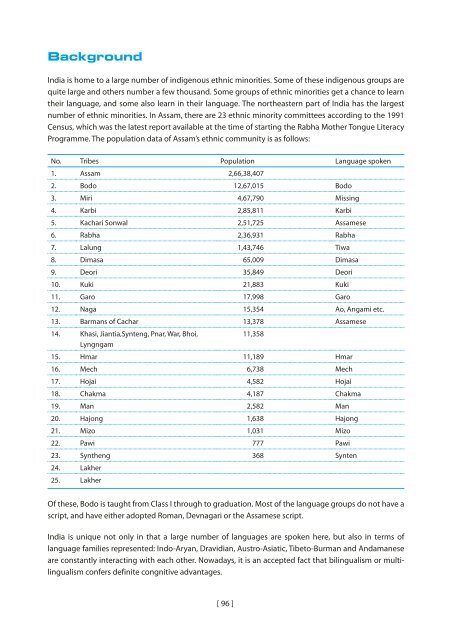Mother Tongue-based Literacy Programmes: Case Studies of Good ...
Mother Tongue-based Literacy Programmes: Case Studies of Good ...
Mother Tongue-based Literacy Programmes: Case Studies of Good ...
Create successful ePaper yourself
Turn your PDF publications into a flip-book with our unique Google optimized e-Paper software.
BackgroundIndia is home to a large number <strong>of</strong> indigenous ethnic minorities. Some <strong>of</strong> these indigenous groups arequite large and others number a few thousand. Some groups <strong>of</strong> ethnic minorities get a chance to learntheir language, and some also learn in their language. The northeastern part <strong>of</strong> India has the largestnumber <strong>of</strong> ethnic minorities. In Assam, there are 23 ethnic minority committees according to the 1991Census, which was the latest report available at the time <strong>of</strong> starting the Rabha <strong>Mother</strong> <strong>Tongue</strong> <strong>Literacy</strong>Programme. The population data <strong>of</strong> Assam’s ethnic community is as follows:No. Tribes Population Language spoken1. Assam 2,66,38,4072. Bodo 12,67,015 Bodo3. Miri 4,67,790 Missing4. Karbi 2,85,811 Karbi5. Kachari Sonwal 2,51,725 Assamese6. Rabha 2,36,931 Rabha7. Lalung 1,43,746 Tiwa8. Dimasa 65,009 Dimasa9. Deori 35,849 Deori10. Kuki 21,883 Kuki11. Garo 17,998 Garo12. Naga 15,354 Ao, Angami etc.13. Barmans <strong>of</strong> Cachar 13,378 Assamese14. Khasi, Jiantia,Synteng, Pnar, War, Bhoi,Lyngngam11,35815. Hmar 11,189 Hmar16. Mech 6,738 Mech17. Hojai 4,582 Hojai18. Chakma 4,187 Chakma19. Man 2,582 Man20. Hajong 1,638 Hajong21. Mizo 1,031 Mizo22. Pawi 777 Pawi23. Syntheng 368 Synten24. Lakher25. LakherOf these, Bodo is taught from Class I through to graduation. Most <strong>of</strong> the language groups do not have ascript, and have either adopted Roman, Devnagari or the Assamese script.India is unique not only in that a large number <strong>of</strong> languages are spoken here, but also in terms <strong>of</strong>language families represented: Indo-Aryan, Dravidian, Austro-Asiatic, Tibeto-Burman and Andamaneseare constantly interacting with each other. Nowadays, it is an accepted fact that bilingualism or multilingualismconfers definite congnitive advantages.[ 96 ]

















